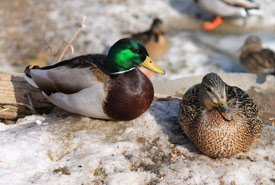
Mallards — male on the left, female on the right. (Photo by Pia Vahabi/NCC staff)
Mallard
One of Canada’s most common ducks, this iconic species is an integral part of habitats across the country.
What does the mallard look like?
Adult mallards can weigh up to 1.4 kilograms. Breeding male adult mallards are the most recognizable, with their emerald green feathers adorning their head and neck. They also have a white collar around their necks, a yellow bill and bright orange legs and feet.
Female mallards are less colourful, with a mottled brown body and dark orange bill. Females can be identified by a white stripe along their wings. Like male mallards, females also have orange legs and feet, but are less vibrant.
Where does the mallard live?
One of the first ducks to return to their breeding range in March or early April, mallards can be found across the country. The highest populations of mallards have been recorded in the Prairie provinces and are rare in Newfoundland and Labrador. The northern most point of mallards in Canada into the Taiga.
Mallards typically breed within Canada and winter in the central and southern U.S. However, some winter in southern Ontario and southern British Columbia. They are primary freshwater ducks, but some find wintering grounds along the coast in the U.S.
What does the mallard eat?
Unlike most ducks, mallards’ diet largely consists of grain — specifically barley and wheat. Mallards will eat a large variety of foods and are surface feeders, consuming insects and small fish while they paddle along in the water.
What is the mallard's conservation status?
Despite being one of the more resilient duck species in Canada, the depletion of habitat in the Prairies has impacted mallard populations in the area. The loss of nesting habitat from droughts during the 1980s and 1990s here have impacted mallard populations, as wetlands have dried up and been converted for agricultural use.
In Atlantic Canada, mallard populations have expanded. There have been many cases in this area of mallards hybridizing with American black duck. However, this has caused population declines in American black duck populations.
What is NCC doing to protect the mallard's habitat?
The Nature Conservancy of Canada (NCC) is protecting numerous habitats across the country where mallards nest and winter. For example, in the Prairies, NCC is conserving 400 hectares in the Oak Lake Sandhills and Wetlands Natural Area. These wetlands support migrating and nesting waterfowl, including mallard. NCC is also protecting the Saskatoon Prairie Natural Area, which includes Saskatoon, Warman and Martensville, the South Saskatchewan River, Moose Wood Sand Hills and Pike Lake Provincial Park. Located in south-central Saskatchewan, this area spans nearly 300,000 hectares of moist mixed grasslands with plains rough fescue prairie.
In New Brunswick, NCC is conserving the Lincoln Wetlands Natural Area. This 8.5-hectare natural area provides habitat for migratory waterfowl, such as wood duck, mallard, American wigeon and green-winged teal.




